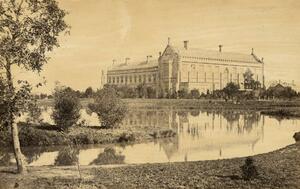Tudor Gothic
The Quadrangle was the first University of Melbourne building, designed by an English architect, Francis M. White in 1854, and commissioned after an architectural competition. White's design was highly influenced by the architectural style of the universities of Oxford and Cambridge. At the time, these universities were facing resistance their preference of awarding degrees to those who subscribed to the established religion of the Church of England. This link between education and religion was a major concern for the reformers in Britain, and the separation of the two was reflected in the University of Melbourne Building Program.
The Tudor Gothic style is considered a secular architectural style that lacks the ecclesiastical features associated with the Gothic style. Tudor architecture evolved from the residential architecture during the time of the Tudor Monarchs. It was focussed on functional houses with features such as gabled roofs, 'Oriel' windows, etc. During the Reformation, Henry VIII, dissolved the monasteries, which were traditionally also places of learning, and founded colleges where students would learn and reside. The architecture of these colleges was partly influeced by the cloisters of the monastries and partly by the Tudor houses. The colleges had a courtyard surrounded by cloisters, with learning spaces, a chapel and student chambers. The Old Quadrangle at the University of Melboune had a similar style but did not include a Chapel, and instead of the student chambers, housed the founding faculty members.
Learn more about Tudor & Tudor Gothic Style
A short history of English architecture / by Hugh Braun.

